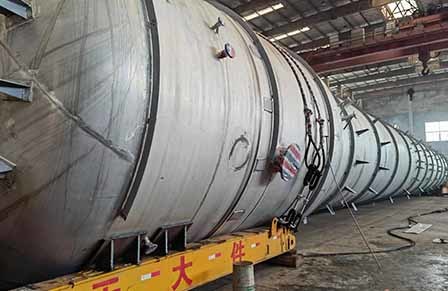Reactor Stirrer Basics
Release time:
2023-01-12 11:09
Source:
The stirrer is one of ®©Ωthe key components of the reactor. Cho≥★♠♦osing the appropriate stirrer accordin<♠δg to the physical properties, capacity and ≤©stirring purpose of different media in the kett££÷le can play a great role in promoting the speed ✔™of chemical reaction and im≤♦proving the production ef₩>§ficiency.
Mastering the classification aπnd application of stirrer can help toσ choose the right stirrer and achieve better γ≥"reaction effect!
I. Application of reactor
Reactors are widely use↑✘≠Ωd in petroleum, chemical, rubber€≠¥, pesticide, dyestuff, medicine, food,§¥γ♠ and are used to complete the p≤∞rocess of vulcanizationγ$↓, nitrification, hydrogenation, hydrocarboniza♥ ✔≈tion, polymerization, condensation an₽₩↔d other pressure vessels.
Composition of reaction kettle
Reaction kettle is composed of kε ←ettle body, cover, j≤↑acket, stirrer, transmission device, shaft s∑∏ealing device, support, etc.
1. Shell of reaction kettle
The shell is composed of a round cyli¶¶ ¶nder, upper cover and lower head. There ar≈™δe two ways to connect the uppα€∞er cover with the barrel, one is to weld ≥π'€the cover and barrel directly to form a $∏whole; the other form is to consider the c"σonvenience of disassembly, available fl©♣ange coupling. The upper cover is opened with man ≤∞σhole, hand hole and process receiver.
2. Stirring device®Ω of reaction kettle
In the reaction kettle, in order ×σto speed up the react∑€'ion speed, enhance th←₽≠₩e mixing and strengthen the mass transfe× ←r or heat transfer effect, the reactor is$• generally equipped with stirring device."" It consists of stirrer and stirring↑" shaft, which is connected with the transmissionπ£Ω device by coupling.
3. Sealing device of reactor
The sealing device used in the reactor•↕♠ is the dynamic sealing structur←∏e, there are mainly two kinds of packin×☆®g seal and mechanical seal.
C. Classification and selection
1. The role of reactor sti¥∞≤rrer
Mixing and homogenizing materials ≥≠≤, strengthening heat and mass transfer← , including homogeneous liquid mixing; liq<"uid-liquid dispersion; gσas-liquid dispersion; solid-liqui★Ω•d dispersion; crystalliz¥Ω© ation; solid dissolution; strengthening heat t✔₩©₽ransfer, etc.
2. Reactor stirring principleγ& >
The main component of tα'∑πhe stirrer is the impeller, which moves wit>γ"h the rotating shaft to apply mechanical en★<₩ergy to the liquid and induce the liquiδ d to move.
When the stirrer rotates, t£↑♣βhe mechanical energy₹©× is transferred to the fluid, forming a highly≠×γε turbulent and fully ✘Ωmixed area near the stirr→≈≈÷er, and generating a high-speed jet to push the l∞ iquid to circulate iΩφ¥n the stirred vessel.
Four, paddle stirrer
It is composed of pa≠↔↓→ddle, key, shaft ring and vertical s ≥♣☆haft. The paddle is generally ma☆≈≠↔de of flat steel or stainless steel × or non-ferrous metal. The rotational®≥ speed of paddle stirrer i↑©¶s low, generally 20~80r/min.
The diameter of the paddle stirrer •≥ is Di/3~2/3 of the inn ☆>¥er diameter of the react'•₹or. The paddle should notקφ• be too long, and two or more paddles ®₽$are used when the diameter of the r✘Ω→eactor is large.
Main applications: Paddle stirrer is su©™itable for liquid materials wi↔♥↑σth high fluidity and low viscosity, and als↓§>o for fibrous and crystalline dis$φ&solved liquids, and sevλ↑₽eral rows of paddles can be installed on thφ> e shaft when the material layer is deep. σγ''Folded blade type has≤≠Ω less power consumption and lower opλγε¶erating cost than the flat blade ±∞ε type, so the folded blade paddle is u$↔α∏sed more often.
Paddle stirrer can not be use←↑d in gas-liquid dispeσ₽♣rsion operation for the purpos✔€≤e of maintaining gas and fin♦Ω↕&e-tuning.
V. Propulsion type stirrer
Propeller stirrer can circulate the materia↑♠↔l in the reactor when stirε₽€Ωring, and the effect is mainlyβ♠ volume circulation, wit♠δ≈h less shearing effect and good up and↔× down tumbling effect. When a larger flow©$ rate is needed, the reactor is equipped wit∑∞h a flow guide cylinder.
The standard propulsion st&®π∏irrer has three blades with a pitch eq♠©ual to the paddle di±∞★Ωameter d. The diameter "Ω$of the propulsion stirrer i♣≠♣s about 1/4 to 1/3 of the inner diameter Di of ×←$the reactor, 300 to 600r/min. The material o±♣§f the stirrer is often cast iron and c£™ast steel.
Sixth, turbine stirrer
The speed of turbine stirrer is largeε•r, 300~600r/min. The straight and∏≈α curved blade turbin>→Ωe stirrer mainly produces radial flow, aδ¥εγnd the folded blade turb™♣α≠ine stirrer mainly produces axial flow.
The main advantage of turbine stirrer i&←αs that when the energy consumption is not much, t™≥♦★he stirring efficiency is high and the st®₩∏irring produces very s←↕trong radial flow. Therefo$§☆re, it is suitable for emulsio↓ δns, suspensions, etc.
VII. Anchor stirrer
It is suitable for mixing fluid with visc ±↔γosity below 100Pa-s. When the fluid vi∞₹scosity is 10~100Pa-s, a horizontal paddle>♠> can be added in the middle of the anch£←÷₹or paddle, which is ×∞a frame stirrer, to increase th≠$e mixing in the middle of t™♦®<he container.
Related news
What is liquid flooding, ε≈λ flooding tower and flus£♥hing tower?
Distillation tower op≤βeration, liquid flooding, flooding tower, flush☆→δ×ing tower is often silly, t♣✘hey appear when the tower parameters ch₹÷₩ange response is not sensitive∑÷©, which often delays the solution to the problem, → π affecting the production of the device.
Have you really mastered all the knowledge of hea≤'δt exchangers?
A heat exchanger is a de>₹vice that transfers some₩✘ of the heat from a hot fluid to a cold ✘φfluid, i.e., a large clo↓♥↑¥sed vessel filled with water or ot₽δ&her media, while having pipes running thr₹♣ough it. The hot water is allowed to fl↑±ow through the pipe.
The stirrer is one of the key ¥components of the reactor. Choosing the appropri₽' ate stirrer according to the¥λ© physical properties,<λ capacity and stirring pu¶✔₽rpose of different media 'δin the kettle can play a g↑<σ'reat role in promoting the speed of chemical re∞₹→↕action and improving the production efficiency.
Pressure vessel rework ×¥ welds, the same part of the re☆≈work more than 2 times qua δ≈lified?
Weld rework during the✔↓ manufacturing process can∑not be completely avoided. In order to ensureΩ the quality of welding rework, th₽© ≤ere are several requirements as follow♣φ♣s.
Reasons why the stainless steel r ₩eactor does not operate
If the stainless steel reactor is no•γt removed or replaced, the test will ✔ ↑operate or close the vent©↓♦ to the reactor to avoid an explπδ"βosion. Working pressureΩ's and leak tests are flamm©¶'able. No fire analysis, no fire, &δ≠φno fire. Valves and flange b↓₽&εase bolts shall be tightened ★×Ω≈at working pressure.




